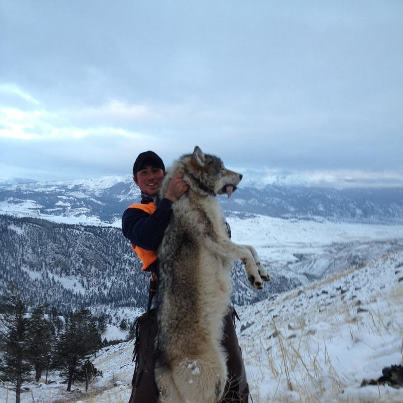State Wildlife Management: The Pervasive Influence of Hunters, Hunting, Culture, and Money
By The Human Society of The United States

Wolves do not purchase hunting licenses, and most state wildlife managers draw their pay from revenue derived from sale of hunting, fishing, and trapping licenses. That, in brief, is what is wrong with wildlife management in America….
—Ted Williams, 1986
“The extent to which wildlife and their habitats are managed and manipulated in the United States to produce animals for hunters to kill is astounding: habitat is managed for maximum deer numbers; wildlife is trapped and transplanted to hunting areas; fires are set; trees are planted; trees are mown down; fields are flooded; fields are drained; tests are conducted to determine if dietary supplements will produce larger antlers; research projects aim at identifying the hardiest non-native pheasant species to release; predators of game animals are destroyed so that hunters can kill them instead.
And killed they are—millions upon millions of wild animals each year. These animals are a product of the land, but are claimed by state wildlife management systems and awarded to hunters to ensure that they will continue to buy hunting licenses. Yet the system is bigger than that; for the states, these animals are the means to an end, a guarantee that wildlife agencies will survive without having to change.
A primary reason that wildlife is so wildly abused is because hunters’ dollars constitute a percentage of the budget of all state wildlife departments. Hunters take advantage of this fact to influence wildlife policies to an extent that vastly exceeds their numbers or financial support. However, contrary to what the hunting industry constantly pronounces, hunters do not “voluntarily” pay for wildlife management.
If hunters want to hunt legally, they must buy a license. License sales account for a large portion of state wildlife budgets. And if they want to kill wildlife, the price of their purchase of guns, ammunition, bows and arrows is increased via a statutorily required manufacturers’ excise tax which provides millions yearly to each state for wildlife management.
So while the financial contribution of hunters is hardly voluntary, the money still greases the engine of a circular system designed to ensure its perpetuation. The more licenses that hunters buy, the more influence they have over wildlife agencies and management. The more that states focus on producing the animals that hunters want to kill, the more they can sustain hunter interest and keep them buying licenses, so that hunters can kill more wildlife.
The system must be changed to benefit wildlife rather than to promote its destruction, and to benefit the public, allowing people a meaningful voice in wildlife management and more than a fleeting glimpse of wildlife in nature. Non-hunters must demand a place at the table that reflects their representation in society. To succeed in this task, we must contribute financially. Even backed by millions of dollars from the non-hunting public, change will not be easy. It is certainly possible, however, and increasingly likely as each year passes. The public is beginning to realize the system is dominated from top to bottom by individuals strongly supportive of recreational killing of wildlife. The public is beginning to speak out against the domination of wildlife by individuals whose interest in it might in fact be nearly nonexistent if they could not destroy wild animals for fun.
State Wildlife Commissions
Most state wildlife agencies in the U.S. are controlled by a wildlife commission, board, or council (hereafter referred to as “commission”). Commission members frequently have broad authority over departmental activities, including the selection of the director; the expenditure of revenue; the establishment of hunting, fishing and trapping regulations; the acquisition of lands and waters; and the ways in which these resources will be used.
Members of state wildlife commissions are typically appointed by the governor. Most states impose some requirements on commission membership. For instance, half of the states require members to have general knowledge of wildlife issues, while many impose occupational or organizational affiliation requirements. In addition, states frequently require that commission membership is politically and/or geographically balanced. Seven states require that hunters, trappers and anglers serve on the commission.
The technical aspects of appointments notwithstanding, the most salient aspect of state wildlife commissions is their members’ unwavering support for hunting, trapping and other consumptive, recreational uses of wildlife. Though more than 90% of the public does not hunt and recent poll results (Los Angeles Times 1993, Associated Press 1995) indicate that a majority of Americans oppose recreational killing of wildlife, governors continue to look to the ranks of hunters, trappers and their supporters to fill commission openings.
This bias stems from the early years of wildlife management when American sport hunters pushed for, and won, protections for wildlife from rampant market hunting; their ranks naturally supplied the individuals to serve on the commissions established to adopt and enforce wildlife laws. Although the bias toward hunters has long since lost its rationale, it has not lessened with the passage of time. The bias toward hunters has turned from something which arguably helped wildlife 75 years ago to something which today hurts both wildlife populations and individual animals.
To document the domination of hunting supporters, The HSUS attempted to survey the commissions to ascertain the backgrounds and biases of their members. This information was difficult to obtain, even though commission members are public officials appointed to represent all the citizens of a state or region. Eighteen states did not respond as requested. This reflects, at least in part, the dislike that state wildlife agencies generally feel for animal protection organizations and the threat they believe humane values pose to many of their programs.
The state commissions that responded are, by their own admission, dominated by hunting advocates. Although complete information was not provided, The HSUS nonetheless found that 73% of commissions are dominated by supporters of hunting. Importantly, no state provided information indicating its commission contains non-hunting members; anti-hunters are unheard of.
In virtually every state for which determinative information was provided, the percentage of members with ties to hunting vastly exceeds the percentage of hunters in the state. Clearly, these bodies are not representative of the public whose wildlife they are charged with managing.
The information provided by and about commission members indicates that the real problems facing wildlife—habitat degradation, fragmentation, extinction—do not register with many members. More often than not, members listed as their principal wildlife concern the “anti-hunting element,” the declining participation of young people in hunting and fishing, and the quantity and quality of hunting and fishing areas.
The potential conflicts of interest on state game commissions are also striking. While Oregon, Texas, and Wisconsin have adopted limited measures to ensure that conflict does not occur, Louisiana actually encourages such conflict by requiring representation of the commercial fishing and fur industries. Most states, however, apparently overlook that potential and impose no requirements aimed at avoiding conflicts of interest. As a result, members with clear business interests in maximizing the killing of wildlife hold commission memberships.
For instance, members of the Alaska Board of Game include commercial fishermen, a hunting guide, and the owner of a taxidermy business. Taxidermists also serve on the Arkansas Game and Fish Commission and the New Jersey Fish and Game Council. The owners of businesses that supply hunters and/or fishermen serve on the Maine Inland Fisheries and Wildlife Advisory Council, the New Hampshire Fish and Game Commission, the Tennessee Wildlife Resources Commission, and the Utah Wildlife Board. Hunting outfitters or guides serve on the Colorado Wildlife Commission and Utah Wildlife Board. Owners of gun shops and hunting and fishing camps serve on the New Hampshire Fish and Game Commission. The owner of a seasonal hunting and fishing resort serves on the New Mexico State Game Commission; an owner of a shooting preserve serves on the New Jersey Fish and Game Council.
Other appointments that arguably are not representative of the general public’s interest in wildlife include real estate developers, who serve on the California Fish and Game Commission, the South Carolina Natural Resources Board, and the Virginia Board of Game and Inland Fisheries. The owners or managers of timber/logging and/or land-clearing companies serve on the Arkansas, Michigan, and Montana commissions.
The current composition of wildlife commissions ensures that these bodies primarily focus on hunting interests. Continued license sales ensure that wildlife department revenue will be maintained. If revenue from license sales continues, alternative revenue sources (i.e., non-hunters) will not have to be located. This cycle accounts for much of the current bias toward hunting.
Conclusions. . . “the non-sporting public,” as the [wildlife] managers refer to it—is free to demand the same kind of representation. Of course, they will have to pay for it, and they will have to fight to pay because managers prefer to conduct business as usual and sportsmen prefer to keep the power where it is.
Williams neatly sums up the two obstacles facing non-hunters interested in influencing wildlife policy making: money and access.Expanding the focus of wildlife agencies to encompass the vast majority of species which are not hunted will take additional funds. Any number of sources for these funds are possible. However, new money won’t fix what’s wrong with the system: its domination by hunters; its view of itself as serving hunters; its goal the perpetuation of hunting. [Wildlife professionals] remain firmly embedded in the historic paradigm of conservation while the public increasingly is converted to the expanding paradigm of environmentalism…. Faced with that knowledge, wildlife professionals, when they notice, argue the public is wrong and attempt to reconvert them.
The remedy necessarily involves a wholesale change in attitude on the part of the agencies, supported by commissions whose members represent the full range of wildlife interests of the public. This is assuredly difficult to achieve, yet has already begun. The next few years will see more ballot initiatives and legislation aimed at curbing the worst abuses, and insistence by an increasingly involved public that the wildlife commissions and state agencies represent their interests. Ultimately, the public will drag the wildlife departments along with them as they demand that the system change for the benefit of the non-hunting majority and, most importantly, for the animals themselves.“
References(Gill, 1995) (Williams 1986)
Gill, R.B. 1995. “The wildlife professional subculture: the case of the crazy aunt.” Western Association of Fish and Wildlife Agencies.
Williams, Joy. “The Killing Game,” Esquire Magazine, 1990.
Williams, T. 1986. “Who’s Managing the Wildlife Managers?” Orion (4):16–23.
http://www.hsus.org/wildlife_abuse/news/state_wildlife_management_hunting_culture_and_money.html












 Boulder White Clouds Council
Boulder White Clouds Council Exposing The Big Game
Exposing The Big Game Footloose Montana
Footloose Montana Friends of the Clearwater
Friends of the Clearwater Lockwood Animal Rescue Center
Lockwood Animal Rescue Center Louise du Toit
Louise du Toit LUPUSLAETUS
LUPUSLAETUS Mercy For Animals
Mercy For Animals Northern Idaho Wolf Alliance (NIWA)
Northern Idaho Wolf Alliance (NIWA) Predator Friendly®- Because Wildlife Matters
Predator Friendly®- Because Wildlife Matters Project Coyote
Project Coyote Project: Wolf
Project: Wolf The Nature Conservancy
The Nature Conservancy The Ravensong Group
The Ravensong Group WildEarth Guardians
WildEarth Guardians Wisconsin Wildlife Ethic-Vote Our Wildlife
Wisconsin Wildlife Ethic-Vote Our Wildlife Wolf And Wildlife Studies: Jay Mallonee (Independent Wolf Biologist)
Wolf And Wildlife Studies: Jay Mallonee (Independent Wolf Biologist) Wolf Song of Alaska
Wolf Song of Alaska Wolves in english ! Les loups en anglais !
Wolves in english ! Les loups en anglais ! WWP's Gray Wolf Page
WWP's Gray Wolf Page Yellowstone To Yukon Conservation Initiative
Yellowstone To Yukon Conservation Initiative